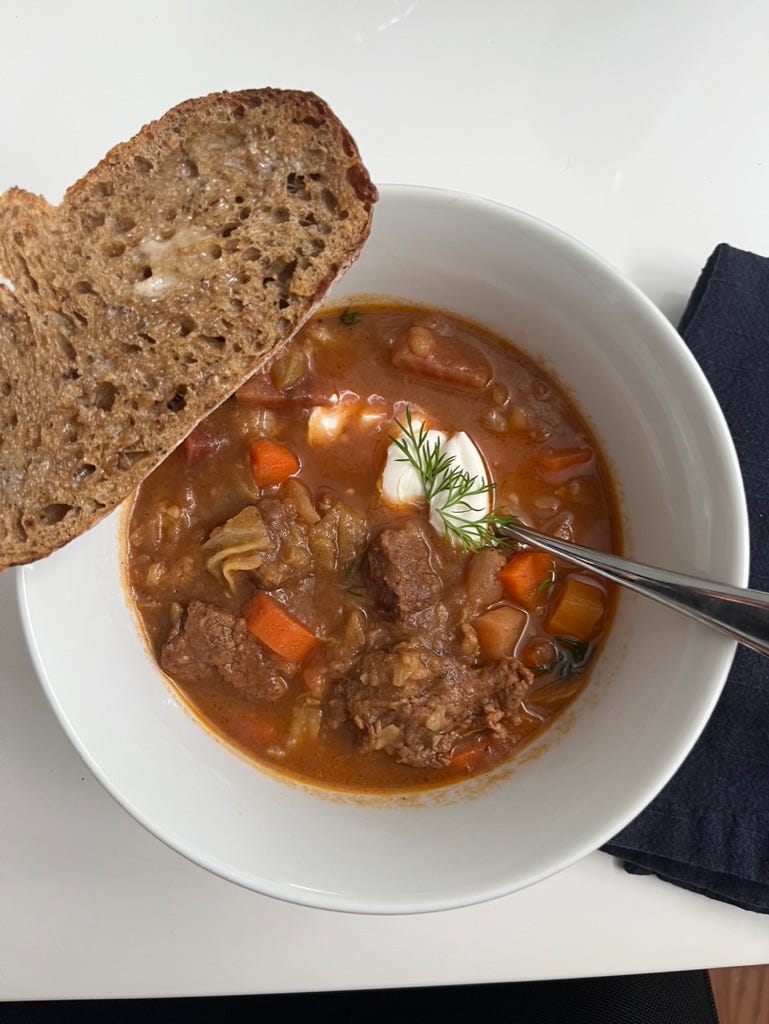These past couple weeks have been so busy for me at work. I’ve been exhausted at night. The thing that so often grounds me no matter how tired (physically or emotionally) I am is cooking dinner. Repetitively chopping up onions and veggies while singing along to Broadway tunes, searing chicken for pot pie and listening to the changes in the sizzles, and meditatively stirring a pot of vodka sauce brings me back into my body the way that yoga does.
This time of year the meals take a little longer and the labor is a little more intense, but there is hope of spring to come! It’s been a very warm winter here in the Deep North, and we’ve barely gotten any snow. So as the days are getting longer, clover is already sprouting and we had rain off and on one day this last week too. I’m mourning the loss of a typical winter, my happiest most calm time of year, while simultaneously welcoming beams of sun on my face and looking forward to all that spring has to offer.
If you need some inspo for the upcoming weeks using seasonal veggies, I’ve got you! Read on for storage tips and dinner ideas for February!
Winter Produce Storage
We got our final winter CSA box this last week! We won’t have another box until the spring share comes in April or May. The goal of this box is obviously not to make it last until then, but to make sure we are using up all the food from this box and then making good use of what we have preserved since last summer.
Below are the classic Deep North Eats tips on how to keep produce fresh as long as possible in your fridge, with a bonus tip on how to preserve it if you want to make it last a little longer.
Beets - Store in a zip top bag in your produce drawer. If they are fresh and stored well, they should last weeks in the fridge (and may even sprout some leaves on the top, which is okay - they will still be safe to eat).
Carrots - Zip top bag with a paper towel to absorb moisture in the fridge.
Daikon radish - Store in a zip top bag in the fridge.
Garlic - Store on the counter in a bowl or vessel with some air flow.
Kohlrabi - Store in a zip top bag in the fridge.
Onions - Keep these on the counter, out of sunlight if you can, with your garlic. Make sure whatever you store it in has good airflow so the onions don’t get moldy!
Parsnips - The one vegetable I’m not eager to eat. I like them more now, so I’m going to be a very brave girl and keep trying them this winter in hopes of liking them more and more. Store in the fridge in a zip top bag - paper towel optional!
Potatoes - Store on the counter in a dark place away from your onions. The aroma ripening onions give off naturally is not good for long term potato storage.
Shallots - Keep these on the counter, out of sunlight if you can, with your garlic. Make sure whatever you store it in has good airflow so they don’t get moldy!
If you love seasonal produce like me, and are curious about how to store things well that aren’t covered above, you can read my previous newsletters here:
Winter Meal Planning
These storage crops last awhile in the fridge, but since they’ve been out of the ground and in storage at the farm, these don’t have as long of a shelf life as the earlier winter boxes. Here are some meal ideas for the coming weeks if you’re needing some inspo.
Aloo Masala: Instead of paneer or chicken, use potatoes as the bulk of the dish!
Borscht: use whatever recipe is your go-to. I personally reference Julia Turshen’s, but also love this one from Natasha’s Kitchen.
Brats & smashed potatoes with dijon aioli: For the potatoes, you’ll boil them whole, then smash them flat. You’ll toss them with some oil, salt and pepper and roast at 425 degrees Fahrenheit for 25 minutes, flipping halfway through.
Dill salmon with potato wedges: Bake salmon with lots of dill, lemon, salt and pepper. Roast some potato wedges alongside the fish in the oven and serve with a dill sour cream sauce for dipping!
Green spaghetti: Inspired by Julia Turshen’s recipe! Blend spinach, kale, basil, parsley, olive oil, and 1 cup of pasta water together. Cook spaghetti for 2 minutes UNDER the package directions, drain and combine with the greens. Cook with cheese until the pasta is al dente.
Homemade hash browns: I swear these are worth the effort! I usually just wing a recipe when I make them so I don’t have a go-to to refer you to for this one.
Roasted chicken thighs, carrots with harissa aioli, and salad with fresh parsley and lemon vinaigrette
Roasted veggie galette: Cube root veggies to similar sizes and toss them with olive oil, salt, pepper, and whatever wintery spices you like. Put on top of a pie pastry and fold the dough up over the veggies to create a crust. Bake and voila!
Root veggie tater tot hotdish: Skip the meat and just throw in whatever root veggies you have on hand, either fresh or frozen. Think potatoes, parsnips, carrots, kale, onions, and garlic mixed with cream of mushroom or cream of celery and cheese. Top with tater tots and bake!
Steak & cheesy parsnip mash: Boil cubed parsnips until they are tender. Mash or blend them with butter, salt, pepper, and whatever cheese you have until they are similar in texture to mashed potatoes. Serve a steak on top of them!
Smoothies: Whatever kind of smoothie you like, throw in some kale that’s been hanging around in the back of the freezer!
Veggie pot pie: Pile in the root veggies in lieu of a protein for a pot pie. Top with biscuits for ease - no need for pie crust!
No matter what you’re feeling at this point of the winter, you deserve delicious food that you are excited about making and eating. Spring and summer will come soon enough!
Things I Like
This stained glass piece of my favorite grandma candy!
We had lunch at Gai Noi last weekend and WOW it was beyond delicious.
I’m really into butter yellow as a color for spring and I’m trying to figure out what clothes I need for spring that I should get in this color!
May your week be gentle and may you eat well. 🌲🥣







